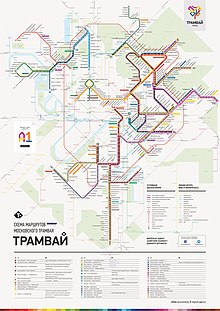Moscow tram
| Moscow tram | |
|---|---|
| A KTM-23 in Moscow | |
| Basic information | |
| Country | Russia |
| city | Moscow |
| opening | June 22, 1872 |
| electrification | April 6, 1899 |
| operator | Mosgortrans |
| Infrastructure | |
| Route length | 181 km |
| Gauge | 1524 mm |
| Power system | 550 volts = overhead line |
| Depots | 5 |
| business | |
| Lines | 41 |
| vehicles | 730 |
The Moscow tram ( Russian Московский трамвай / Moskowski Tramwai ) is the tram in the Russian capital Moscow . It has a track width of 1524 mm and a voltage of 550 V DC. A total of 41 lines operate on two separate networks with a total length of 181.2 kilometers (January 2013), which mainly serve as feeder functions for the metro . The Moscow tram is operated by the Mosgortrans municipal transport company .
history
The network goes back to the first horse tram , which was built by the Belgian company Compagnie générale des tramways de Moscou et de Russie and opened on June 22nd, 1872. The first steam tram ran on July 29, 1886, the first electric tram on April 6, 1899. However, as people were skeptical about the electric train, the opening of the second line was delayed until August 3, 1903. The railways were taken over in 1911 by the city, which had founded its own tram company in 1904. By 1912, all routes except for a steam tram line were electrified.
From 1935, the railroad received competition from the new metro; several routes (especially in the city center) have been discontinued. In the 1950s and 1960s there were plans to completely replace the tram with trolleybuses . This was because Nikita Khrushchev was enthusiastic about this transport system. In 1983, plans were then presented to extend the existing routes by almost 200 kilometers. Except for the new line to Strogino in the north-west of the city, none of the lines were implemented.
business
The railway has some special features. There are two separate subnets. The larger one covers about three quarters of the routes and is mainly in the south and east of the city. The smaller one is in the northwest.
The northern part of the “large” network, also known as the Jausa network , emerged from the end of the 19th century, mainly to the left of the Moskva . The lines to the right of the Moskva and to the south of the city were mostly laid out in the 1950s to 1960s; this part is also known as the Apakow network , after its first depot on Schabolowka Street not far from the Schuchow radio tower . Since the end of the 1980s, there has only been one connection between the Jausa and Apakow networks via the Novospassky Bridge of the Moskva, over which lines 35 and 38 now operate (status: 2014).
The sub-network in the north-west of Moscow was also mainly built in the 1950s to 1960s, the line to Strogino in 1981/1982. According to this, the subnet is also referred to as the Strogino network . Since the line to the Sokol metro station was dismantled in 1973, there has been no connection between the sub-networks, and there is even no operational line .
As is customary in the successor states of the Soviet Union , line numbers in Moscow are also assigned twice or three times to the three urban means of transport tram, trolleybus and bus . In addition, Mosgortrans also uses red line numbers for short-run repeater lines on trams .
Web links
- http://www.mosgortrans.com Official Mosgortrans website
- http://tram.ruz.net/ Unofficial fan site of the Moscow tram
- Moscow tram network map (Russian), as of December 8, 2014




